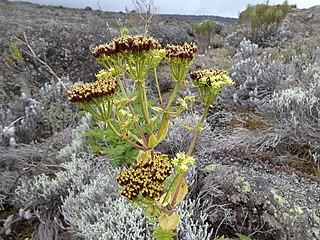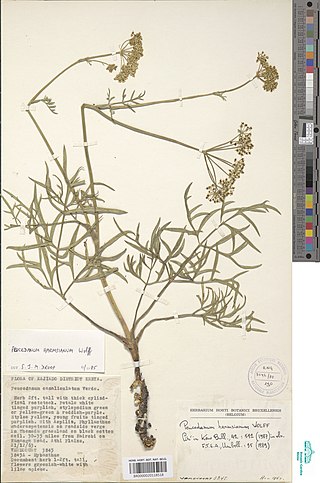
Echinocereus is a genus of ribbed, usually small to medium-sized, cylindrical shaped cacti, comprising about 70 species native to the southern United States and Mexico in very sunny, rocky places. Usually the flowers are large and the fruit edible.

Abies numidica, the Algerian fir, is a species of fir found only in Algeria, where it is endemic on Djebel Babor, the second-highest mountain in the Algerian Tell Atlas.
Senecio maranguensis a 2-meter (6 foot) woody shrub or 6 meter (20 feet) climbing shrub from the family Asteraceae and species of the genus Senecio which makes its home at the same altitudes as the bamboo on the slopes of the mountains in East Africa.

Eucrypta chrysanthemifolia is a species of flowering plant in the waterleaf family known by the common name spotted hideseed.
Tetrapteron palmeri is a species of evening primrose known by the common name Palmer evening primrose. It is native to the western United States from California to Idaho, where it grows in several habitat types, including desert and sagebrush. It is a roughly hairy annual herb growing in a low patch on the ground, generally with no stem. The leaves are widely lance-shaped and up to about 5 centimeters long, with a few small teeth along the edges. The nodding inflorescence produces flowers with yellow petals only 2 or 3 millimeters long each and a noticeable bulbous stigma tip which may be up to a centimeter wide. The fruit is a leathery capsule around half a centimeter long with small wings near the tip.

Lupinus truncatus is a species of lupine known by the common name collared annual lupine.
Minuartia pusilla is a species of flowering plant in the family Caryophyllaceae known by the common names annual sandwort and dwarf stitchwort.

Minuartia rubella is a species of flowering plant in the family Caryophyllaceae known by several common names, including beautiful sandwort, mountain sandwort, Arctic sandwort, and boreal stitchwort. It has a circumboreal distribution, occurring throughout the northernmost Northern Hemisphere from the Arctic Circle on the Arctic tundra into the alpine climates of mountainous areas in temperate Eurasia and North America. It grows in rocky, moist, often barren habitat, including gravelly, sparsely vegetated slopes with little organic matter. It is a calciphile, growing in calcareous substrates such as soils rich in decomposed limestone.

Smilax laurifolia is a species of flowering plant in the greenbrier family known by the common names laurel greenbrier, laurelleaf greenbrier, bamboo vine, and blaspheme vine. It is native to the southeastern United States, where it occurs along the Gulf and Atlantic coastal plains from Texas to New Jersey, the range extending inland to Arkansas, Oklahoma, and Tennessee. It also occurs in Cuba and the Bahamas.

Afrosciadium is a genus of flowering plants belonging to the carrot family, Apiaceae. It was split from the genus Peucedanum in 2008 by P.J.D. Winter, et al.

Afrosciadium harmsianum is a member of the carrot family, Apiaceae. It is a perennial tuberous herb native to east tropical Africa, while the subspecies A. h. australe is endemic to northern Tanzania.

Afrosciadium caffrum is a member of the carrot family, Apiaceae. It is a perennial tuberous herb native to subtropical regions in eastern South Africa.

Afrosciadium magalismontanum is a member of the carrot family, Apiaceae. It is a perennial tuberous herb native to subtropical regions in eastern South Africa and Eswatini. It has a tall, narrow stem which divides into multiple evenly-spaced branches near the top, with each branch sporting a cluster of small yellow flowers at its end.

Afrosciadium dispersum is a member of the carrot family, Apiaceae. It is a perennial tuberous herb native to tropical mountains in South Sudan, northern Uganda, and southwestern Tanzania.

Afrosciadium eylesii is a member of the carrot family, Apiaceae. It is a perennial tuberous herb native to southeastern Africa, from the Democratic Republic of the Congo and Tanzania to Zimbabwe and Mozambique.

Afrosciadium friesiorum is a member of the carrot family, Apiaceae. It is a perennial tuberous herb, endemic to Mount Kenya.

Afrosciadium gossweileri is a member of the carrot family, Apiaceae. It is a perennial tuberous herb, endemic to subtropical Angola.

Afrosciadium lundense is a member of the carrot family, Apiaceae. It is a perennial tuberous herb, endemic to subtropical Angola.

Afrosciadium lynesii is a member of the carrot family, Apiaceae. It is a perennial tuberous herb native to southern tropical Africa.
Afrosciadium natalense is a member of the carrot family, Apiaceae. It is a perennial tuberous herb, endemic to the KwaZulu-Natal province of South Africa.
















